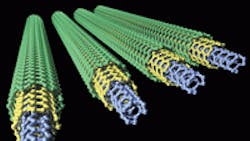The buckyball was named after R. Buckminster Fuller because of its resemblance to the late architect's geodesic domes. The buckyball is a nanometer, or one-billionth of a meter, in diameter and consists of 60 carbon atom cages that form the shape of a soccer ball. The unique form of carbon was noted for its strength but did not find use in many applications until it led the way to the creation of nanotubes years later, says Wade Adams, director of the Richard E. Smalley Institute for Nanoscale Science and Technology. Nanotubes consist of elongated versions of carbon molecules called fullerenes that can conduct heat and electricity better than any other known material.
Nanotubes have been used in various applications over the years, including reinforcements for composite materials. In January Bayer Material Science opened a pilot facility in the North Rhine-Westphalia region of Germany capable of producing 200 metric tons of carbon nanotubes annually. The company says potential applications include use as a strengthening agent for polymer matrices and metal systems or in coatings for ships because of its abrasion-resistant properties.
See Also:
• Nanotechnology: Beyond the Hype
About the Author
Jonathan Katz
Former Managing Editor
Former Managing Editor Jon Katz covered leadership and strategy, tackling subjects such as lean manufacturing leadership, strategy development and deployment, corporate culture, corporate social responsibility, and growth strategies. As well, he provided news and analysis of successful companies in the chemical and energy industries, including oil and gas, renewable and alternative.
Jon worked as an intern for IndustryWeek before serving as a reporter for The Morning Journal and then as an associate editor for Penton Media’s Supply Chain Technology News.
Jon received his bachelor’s degree in Journalism from Kent State University and is a die-hard Cleveland sports fan.
